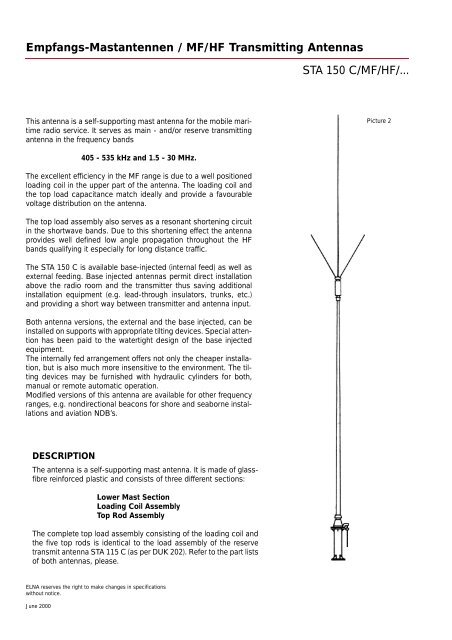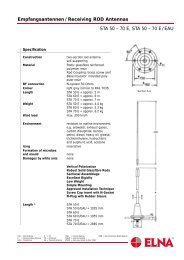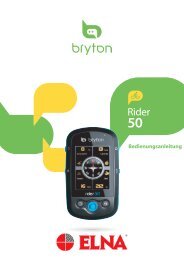Mastantennen / Mast-Antennas STA 40 M, STA 50 M, STA 60 M
Mastantennen / Mast-Antennas STA 40 M, STA 50 M, STA 60 M
Mastantennen / Mast-Antennas STA 40 M, STA 50 M, STA 60 M
Create successful ePaper yourself
Turn your PDF publications into a flip-book with our unique Google optimized e-Paper software.
Empfangs-<strong><strong>Mast</strong>antennen</strong> / MF/HF Transmitting <strong>Antennas</strong><br />
This antenna is a self-supporting mast antenna for the mobile maritime<br />
radio service. It serves as main - and/or reserve transmitting<br />
antenna in the frequency bands<br />
ELNA reserves the right to make changes in specifications<br />
without notice.<br />
June 2000<br />
<strong>40</strong>5 - 535 kHz and 1.5 - 30 MHz.<br />
The excellent efficiency in the MF range is due to a well positioned<br />
loading coil in the upper part of the antenna. The loading coil and<br />
the top load capacitance match ideally and provide a favourable<br />
voltage distribution on the antenna.<br />
The top load assembly also serves as a resonant shortening circuit<br />
in the shortwave bands. Due to this shortening effect the antenna<br />
provides well defined low angle propagation throughout the HF<br />
bands qualifying it especially for long distance traffic.<br />
The <strong>STA</strong> 1<strong>50</strong> C is available base-injected (internal feed) as well as<br />
external feeding. Base injected antennas permit direct installation<br />
above the radio room and the transmitter thus saving additional<br />
installation equipment (e.g. lead-through insulators, trunks, etc.)<br />
and providing a short way between transmitter and antenna input.<br />
Both antenna versions, the external and the base injected, can be<br />
installed on supports with appropriate tilting devices. Special attention<br />
has been paid to the watertight design of the base injected<br />
equipment.<br />
The internally fed arrangement offers not only the cheaper installation,<br />
but is also much more insensitive to the environment. The tilting<br />
devices may be furnished with hydraulic cylinders for both,<br />
manual or remote automatic operation.<br />
Modified versions of this antenna are available for other frequency<br />
ranges, e.g. nondirectional beacons for shore and seaborne installations<br />
and aviation NDB’s.<br />
DESCRIPTION<br />
The antenna is a self-supporting mast antenna. It is made of glassfibre<br />
reinforced plastic and consists of three different sections:<br />
Lower <strong>Mast</strong> Section<br />
Loading Coil Assembly<br />
Top Rod Assembly<br />
The complete top load assembly consisting of the loading coil and<br />
the five top rods is identical to the load assembly of the reserve<br />
transmit antenna <strong>STA</strong> 115 C (as per DUK 202). Refer to the part lists<br />
of both antennas, please.<br />
<strong>STA</strong> 1<strong>50</strong> C/MF/HF/...<br />
Picture 2





